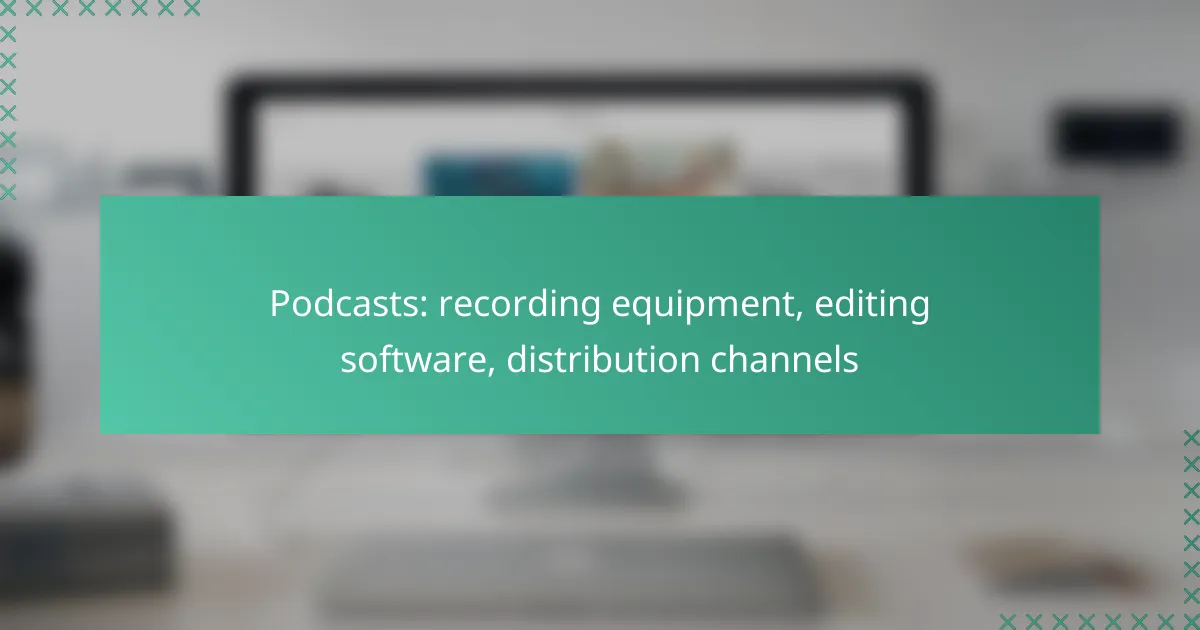Creating a successful podcast requires the right combination of recording equipment, editing software, and distribution channels. High-quality microphones and audio interfaces are essential for capturing clear sound, while user-friendly editing software can enhance your audio quality. Once your podcast is ready, platforms like Apple Podcasts and Spotify provide effective channels for reaching your audience and maximizing engagement.
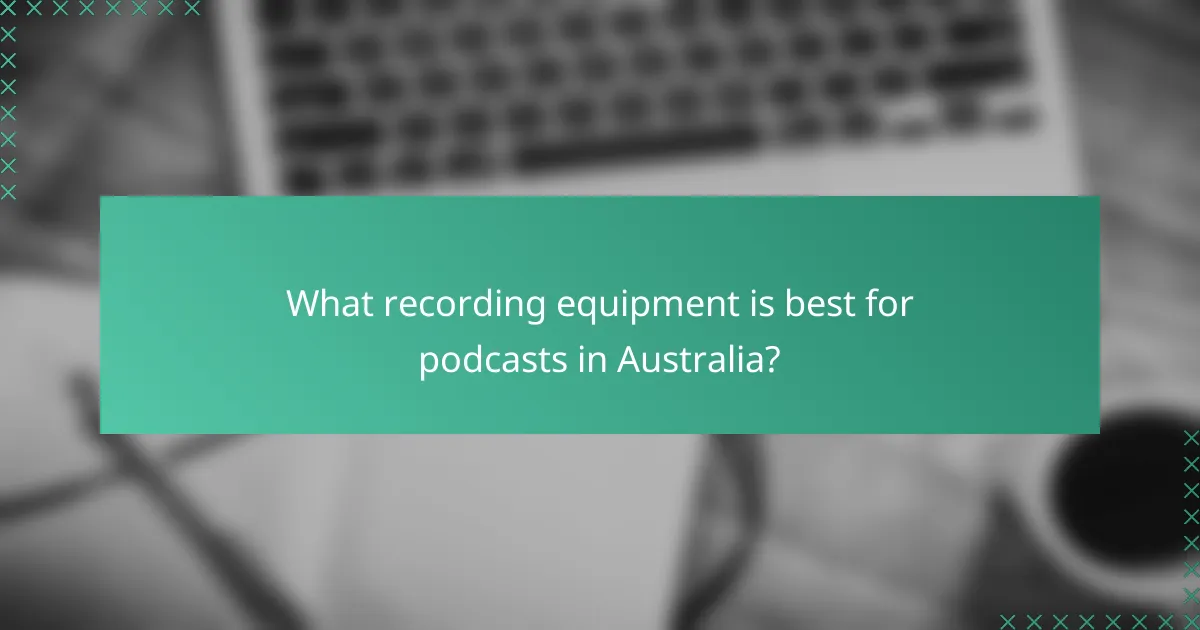
What recording equipment is best for podcasts in Australia?
The best recording equipment for podcasts in Australia includes high-quality microphones, portable recorders, and audio interfaces that enhance sound clarity and ease of use. Popular choices among podcasters focus on durability, sound quality, and compatibility with various recording setups.
Shure SM7B microphone
The Shure SM7B is a dynamic microphone renowned for its versatility and rich sound quality, making it a favorite among professional podcasters. It excels in capturing vocals with clarity while minimizing background noise, thanks to its built-in air suspension system.
This microphone requires a good preamp due to its low output level, so pairing it with a quality audio interface is essential. It’s often used in radio stations and studios, reflecting its reliability in demanding environments.
Audio-Technica AT2020 microphone
The Audio-Technica AT2020 is a popular choice for beginner and intermediate podcasters due to its affordability and excellent sound quality. This condenser microphone captures a wide frequency range, making it suitable for various vocal styles.
It connects easily to most audio interfaces and offers a cardioid pickup pattern that reduces ambient noise. This microphone is a solid investment for those starting out or looking to upgrade their recording setup without breaking the bank.
Zoom H6 portable recorder
The Zoom H6 is a versatile portable recorder that allows podcasters to record high-quality audio on the go. It features interchangeable microphone capsules, enabling users to customize their recording setup based on specific needs.
This device is ideal for field recordings or interviews, as it can capture multiple audio sources simultaneously. Its user-friendly interface and battery operation make it a practical choice for podcasters who need flexibility and mobility.
Rode NT1-A microphone
The Rode NT1-A is a condenser microphone known for its low self-noise and wide dynamic range, making it perfect for capturing detailed vocal performances. Its cardioid pattern helps isolate the sound source while minimizing background noise.
This microphone is often recommended for home studios and is compatible with various audio interfaces, making it a great option for podcasters looking to achieve studio-quality recordings. Its affordability and performance make it a popular choice in Australia.
Focusrite Scarlett 2i2 audio interface
The Focusrite Scarlett 2i2 is a highly regarded audio interface that provides high-quality preamps and converters, essential for any podcasting setup. It offers two inputs, allowing for the connection of multiple microphones or instruments simultaneously.
This interface is user-friendly and compatible with most recording software, making it an excellent choice for both beginners and experienced podcasters. Its compact design and reliable performance make it a staple in many Australian podcasting studios.
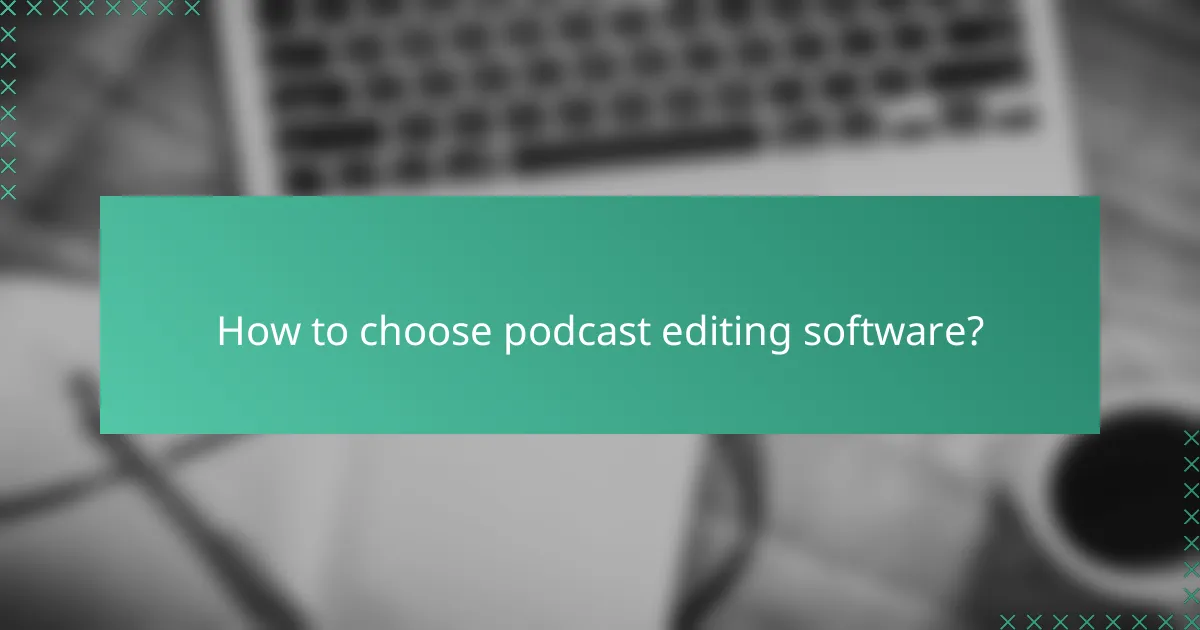
How to choose podcast editing software?
Choosing podcast editing software involves considering your skill level, budget, and specific editing needs. Look for features that enhance audio quality, ease of use, and compatibility with your recording equipment.
Adobe Audition features
Adobe Audition is a professional-grade audio editing software known for its extensive features. It offers multitrack editing, noise reduction tools, and a wide range of audio effects, making it suitable for both beginners and experienced podcasters.
Key features include spectral frequency display for visualizing audio, automatic speech alignment, and support for various file formats. However, it requires a monthly subscription, which may not fit every budget.
Audacity’s free capabilities
Audacity is a popular free audio editing software that provides essential editing tools for podcasters. It allows users to record live audio, edit tracks, and apply effects like normalization and compression.
While it lacks some advanced features of paid software, its open-source nature and community support make it a great choice for beginners. Users should note that it may have a steeper learning curve compared to other free options.
GarageBand for Mac users
GarageBand is a user-friendly audio editing software available for Mac users, offering a range of features tailored for podcasting. It includes pre-recorded loops, virtual instruments, and easy-to-use editing tools.
This software is ideal for those who want to create polished podcasts without investing in expensive software. However, its functionality is limited to Mac, which may not suit all users.
Reaper for advanced editing
Reaper is a versatile audio editing software favored by advanced users for its customizable interface and powerful features. It supports multitrack recording, MIDI editing, and a vast array of plugins, making it suitable for complex projects.
While it offers a free trial, a license is required for continued use, which is relatively affordable compared to other professional software. Users should be prepared for a learning curve to fully utilize its capabilities.
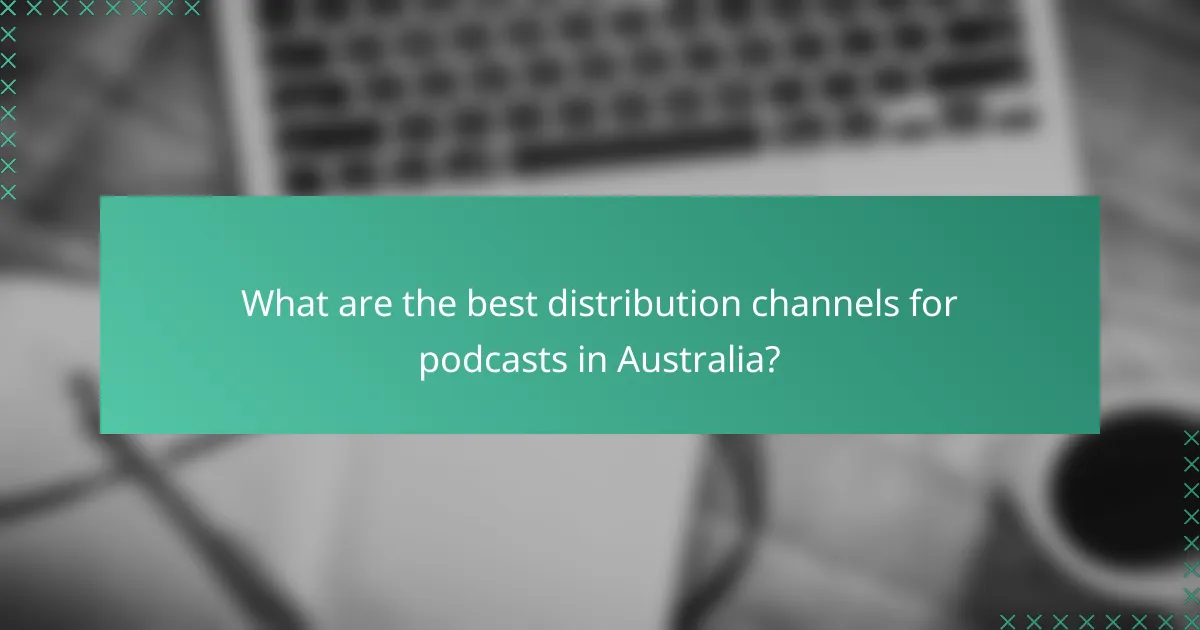
What are the best distribution channels for podcasts in Australia?
The best distribution channels for podcasts in Australia include Apple Podcasts, Spotify, Google Podcasts, and Stitcher. Each platform offers unique advantages in terms of audience reach, engagement, accessibility, and catering to niche markets.
Apple Podcasts reach
Apple Podcasts is one of the most popular platforms for podcast distribution in Australia, boasting a significant share of the market. With millions of active users, it provides a vast audience for creators looking to grow their listener base.
To maximize reach on Apple Podcasts, ensure your podcast is properly categorized and optimized for search. Use relevant keywords in your title and description to improve visibility in the platform’s search results.
Spotify’s audience engagement
Spotify has rapidly gained traction as a podcast distribution channel, particularly among younger audiences. Its integrated music and podcast features encourage users to engage with content more frequently.
To enhance audience engagement on Spotify, consider creating playlists that combine music with your podcast episodes. This strategy can attract listeners who enjoy both formats and increase overall listening time.
Google Podcasts accessibility
Google Podcasts offers easy accessibility for users across various devices, including Android smartphones and smart speakers. This platform is particularly beneficial for reaching audiences who prefer Google services.
To leverage Google Podcasts effectively, ensure your podcast is indexed correctly on Google. This can be achieved by submitting your RSS feed to Google Search Console, which helps improve discoverability in search results.
Stitcher for niche audiences
Stitcher is a valuable platform for targeting niche audiences, especially those interested in specific genres like comedy, true crime, or business. Its curated content and recommendations help connect creators with dedicated listeners.
When using Stitcher, focus on creating content that resonates with your niche audience. Engaging with listeners through social media or community forums can also enhance loyalty and encourage word-of-mouth promotion.
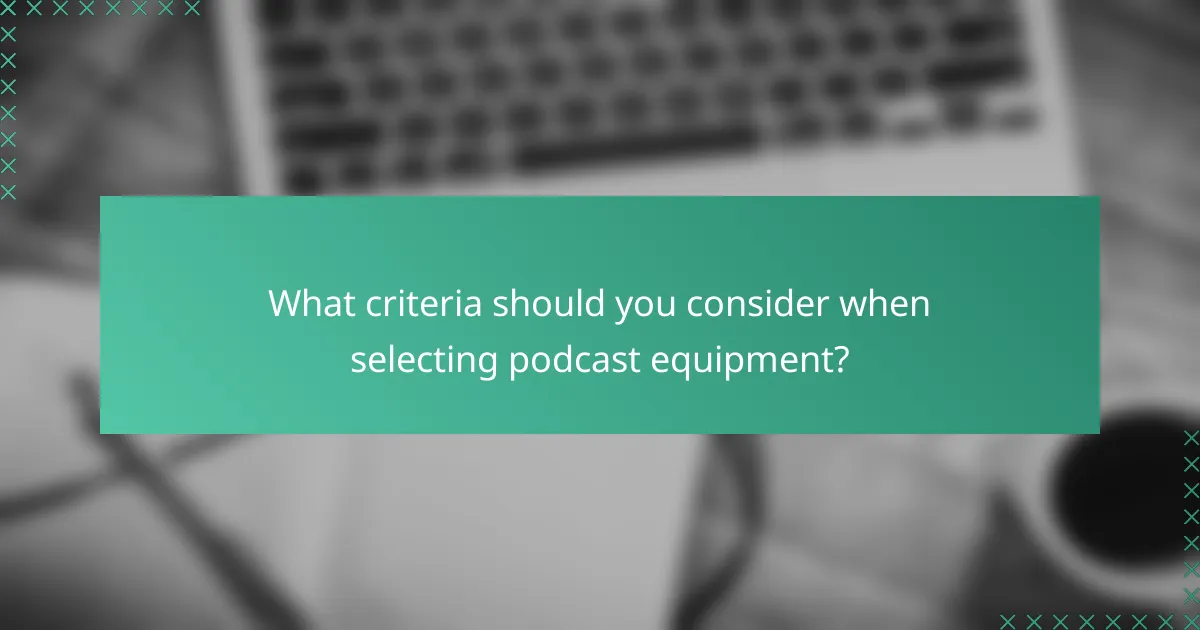
What criteria should you consider when selecting podcast equipment?
When selecting podcast equipment, consider factors such as budget, audio quality, and portability. These criteria will help ensure you choose the right tools for your podcasting needs while balancing performance and cost.
Budget constraints
Your budget is a primary factor in selecting podcast equipment. Entry-level microphones can range from $50 to $150, while professional-grade options may exceed $500. Determine how much you are willing to invest and prioritize essential gear within that budget.
Consider not just the initial purchase price but also ongoing costs like software subscriptions or replacement parts. Look for bundles that include microphones, headphones, and accessories to maximize value.
Audio quality requirements
Audio quality is crucial for a professional-sounding podcast. Aim for equipment that captures clear sound and minimizes background noise. A good condenser microphone is often recommended for voice recording, while dynamic microphones can be better for noisy environments.
Check specifications such as frequency response and sensitivity. A microphone with a frequency response of 20 Hz to 20 kHz is generally suitable for voice. Testing different setups can help you find the best sound for your specific needs.
Portability needs
Portability is important if you plan to record in various locations. Lightweight and compact equipment, such as handheld recorders or USB microphones, can make on-the-go recording easier. Consider how often you will need to transport your gear.
Evaluate the durability of your equipment as well. If you travel frequently, investing in rugged, portable cases can protect your gear from damage. Always consider the ease of setup and breakdown when choosing portable options.
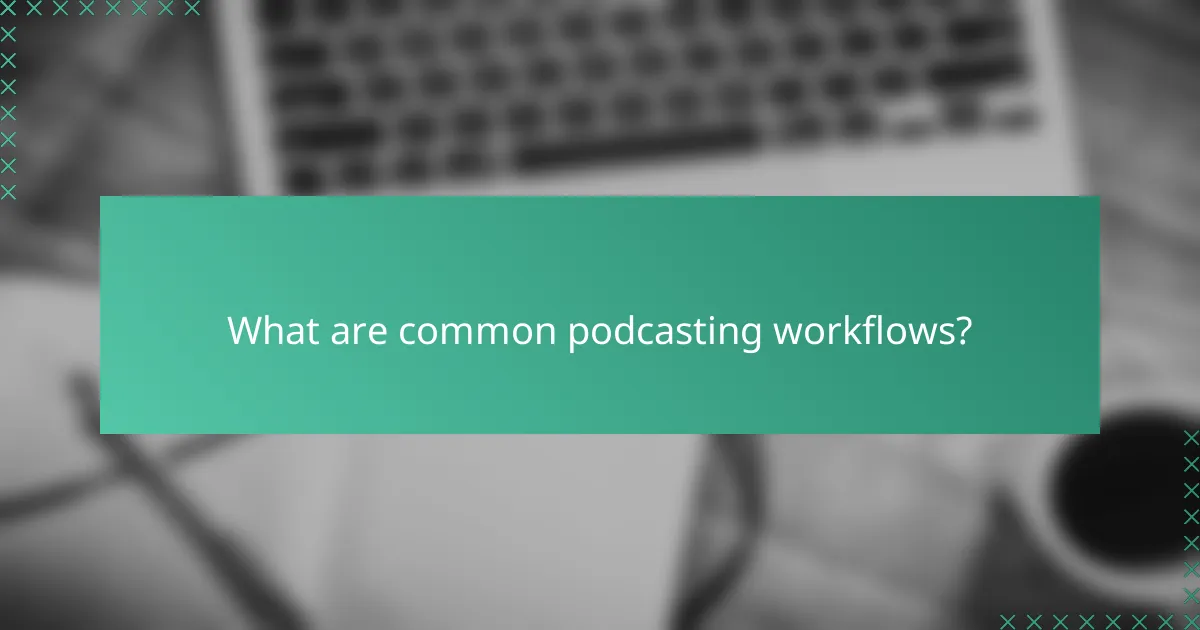
What are common podcasting workflows?
Common podcasting workflows involve a series of steps from planning and recording to editing and distribution. Each stage requires specific tools and techniques to ensure a polished final product that reaches the intended audience effectively.
Recording Equipment
Recording equipment is crucial for capturing high-quality audio. Essential items include a good microphone, headphones, and an audio interface. Popular microphone choices range from USB mics for beginners to XLR mics for more professional setups.
When selecting equipment, consider your budget and the environment in which you’ll be recording. For instance, a quiet home studio can benefit from dynamic microphones, while condenser mics may be better for controlled environments. Aim for a setup that minimizes background noise and captures clear sound.
Editing Software
Editing software helps refine your podcast by allowing you to cut, arrange, and enhance audio tracks. Common options include Audacity, GarageBand, and Adobe Audition, each offering different features suited for various skill levels.
When choosing editing software, consider factors like ease of use, available features, and cost. Many beginners start with free options like Audacity, while professionals might prefer more advanced tools that offer extensive editing capabilities. Familiarize yourself with basic editing techniques, such as noise reduction and equalization, to improve audio quality.
Distribution Channels
Distribution channels are platforms where your podcast is published and made accessible to listeners. Popular channels include Apple Podcasts, Spotify, and Google Podcasts, each with its own audience and submission guidelines.
To effectively distribute your podcast, create an RSS feed that complies with the specifications of your chosen platforms. Consider promoting your episodes on social media and your website to increase visibility. Regularly check analytics to understand listener engagement and adjust your strategy accordingly.
